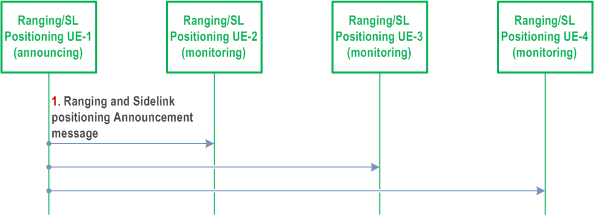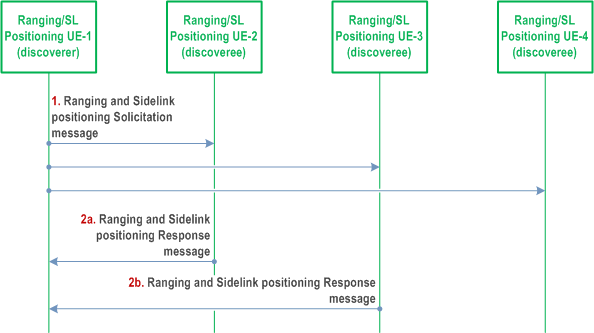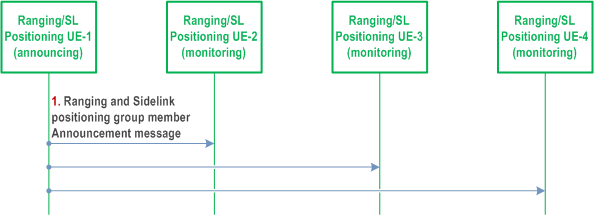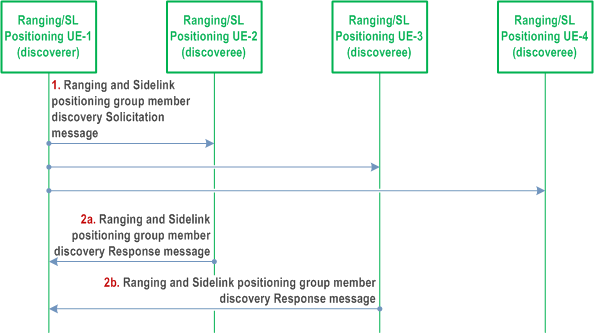Content for TS 23.586 Word version: 18.6.0
6.4 Procedures for UE Discovery
6.4.1 General
6.4.2 Ranging/SL Positioning UE discovery with 5G ProSe capable UE
6.4.3 Ranging/SL Positioning UE discovery with V2X capable UE
...
...
6.4 Procedures for UE Discovery p. 35
6.4.1 General p. 35
The procedure for Ranging/Sidelink Positioning UE discovery with 5G ProSe capable UE uses both Model A discovery and Model B discovery as defined in clause 6.3.2 of TS 23.304.
The procedure for Ranging/Sidelink Positioning UE discovery with V2X capable UE uses the procedures for V2X communication over PC5 reference point as defined in TS 23.287.
6.4.2 Ranging/SL Positioning UE discovery with 5G ProSe capable UE p. 35
6.4.2.1 Ranging/SL Positioning UE direct discovery p. 35
As defined for the Model A and Model B discovery in TS 23.304:
- Model A uses a single discovery protocol message (Announcement).
- Model B uses two discovery protocol messages (Solicitation and Response).

Step 1.
Figure 6.4.2.1-2 illustrates the procedure for Ranging/SL Positioning UE discovery with 5G ProSe capable in Model B discovery.
The Announcing UE (UE-1) sends a Ranging/SL Positioning Announcement message. The Ranging/SL Positioning Announcement message includes the Type of Discovery Message, security protection element, RSPP metadata information, the User Info ID of Announcing UE and optionally serving PLMN ID of Announcing UE.
Announcing UE can be SL Reference UE, Located UE and SL Positioning Server UE.
The Destination Layer-2 ID used to send the Ranging/SL Positioning Announcement message is configured in clause 5.2.
The Source Layer-2 ID to send the Ranging/SL Positioning Announcement message is self-assigned by the Announcing UE.
Announcing UE sends the Announcement message only if it is authorized to be the corresponding UE role in RSPP metadata information.
The User Info ID of Announcing UE is the Announcing UE's Application Layer ID.
A Monitoring UE determines the Destination Layer-2 ID for signalling reception based on the configuration in clause 5.2.
A Monitoring UE selects the Announcing UE based on the information received in step 1.
Announcing UE may include an indication of whether its serving network supports Ranging/SL Positioning.
Announcing UE may include its serving PLMN ID in the Announcement message if its role is Located UE.
The contents of RSPP metadata information (e.g. the UE Role) are defined in clause 6.11 of TS 38.355.

Step 1.
The Discoverer UE (UE-1) sends a Ranging/SL Positioning Solicitation message. The Ranging/SL Positioning Solicitation message includes the Type of Discovery Message, security protection element, optionally User Info ID of Discoveree UE, User Info ID of Discoverer UE and optionally RSPP metadata information.
The Destination Layer-2 ID used to send the Ranging/SL Positioning Solicitation message is configured in clause 5.2.
The Source Layer-2 ID to send the Ranging/SL Positioning Solicitation message is self-assigned by the Discoverer UE.
The User Info ID of Discoverer UE is the discoverer UE's Application Layer ID.
User Info ID of Discoveree UE is to identify a specific UE that the discoverer UE would like to discover, which is identified by Discoveree UE's Application Layer ID.
A Discoveree UE determines the Destination Layer-2 ID for signalling reception based on the configuration in clause 5.2.
Discoverer UE may include an indication of whether its serving network supports Ranging/SL Positioning.
The contents of RSPP metadata information (e.g., the UE Role) are defined in clause 6.11 of TS 38.355.
Step 2.
The Discoveree UE that matches the Ranging/SL Positioning solicitation message (e.g. RSPP metadata information) responds to the Discoverer UE with the Ranging/SL Positioning Response message. The Ranging/SL Positioning Response message includes Type of Discovery Message, security protection element, RSPP metadata information, optionally serving PLMN ID of Discoveree UE, user Info ID of the Discoveree UE.
The Source Layer-2 ID used to send the Ranging/SL Positioning Response message is specified in clause 5.2.
The Destination Layer-2 ID is set to the Source Layer-2 ID of the received Ranging/SL Positioning Solicitation message.
The User Info ID of Discoveree UE is the Discoveree UE's Application Layer ID.
Discoveree UE sends the Response message only if it is authorized to be the corresponding UE role in the solicitation message.
The Discoverer UE selects the Discoveree UE based on the information received in step 2, when User Info ID of Discoveree UE is not included in Ranging/SL Positioning Solicitation message.
Discoveree UE may include an indication of whether its serving network supports Ranging/SL Positioning.
Discoveree UE may include its serving PLMN ID in the Ranging/SL Positioning Response message if its role is Located UE.
The contents of RSPP metadata information (e.g. the UE Role) are defined in clause 6.11 of TS 38.355.
6.4.2.2 Ranging/SL Positioning group member discovery with 5G ProSe capable UE p. 37
Figure 6.4.2.2-1 illustrates the procedure for Ranging/SL Positioning group member discovery with 5G ProSe capable in Model A discovery.

Step 1.
Figure 6.4.2.2-2 illustrates the procedure for Ranging/SL Positioning Group member discovery with 5G ProSe capable in Model B discovery.
The Announcing UE sends a Ranging/SL Positioning Group member discovery Announcement message. The Announcement message includes the Type of Discovery Message, optionally serving PLMN ID of Announcing UE, User info ID of the Announcing UE, Group ID and RSPP metadata information.
The Destination Layer-2 ID used to send and receive the Ranging/SL Positioning Group member discovery Announcement message is described in clause 5.8.1.2 of TS 23.304.
The Source Layer-2 ID used to send and the Ranging/SL Positioning Group member discovery Announcement message is self-assigned by the Announcing UE.
Announcing UE sends the Announcement message only if it is authorized to be the corresponding UE role in RSPP metadata information.
The User Info ID of Announcing UE is the Announcing UE's Application Layer ID.
Announcing UE may include an indication of whether its serving network supports Ranging/SL Positioning.
Announcing UE may include its serving PLMN ID in the Announcement message if its role is Located UE.
The contents of RSPP metadata information (e.g. the UE Role) are defined in clause 6.11 of TS 38.355.

Step 1.
The Discoverer UE (UE-1) sends a Ranging/SL Positioning Group member discovery Solicitation message. The Solicitation message includes the Type of Discovery Message, User Info ID of Discoverer, Group ID, optionally User Info ID of Discoveree UE and optionally RSPP metadata information.
The Destination Layer-2 ID used to send and receive the Solicitation message is described in clause 5.8.1.2 of TS 23.304.
The Source Layer-2 ID to send the Ranging/SL Positioning Solicitation message is self-assigned by the Discoverer UE.
The User Info ID of Discoverer UE is the Discoverer UE's Application Layer ID.
User Info ID of Discoveree UE is to identify a specific UE that the discoverer UE would like to discover, which is identified by Discoveree UE's Application Layer ID.
Discoverer UE may include an indication of whether its serving network supports Ranging/SL Positioning.
The contents of RSPP metadata information (e.g. the UE Role) are defined in clause 6.11 of TS 38.355.
Step 2.
The Discoveree UE that matches the values of the parameters (including Group ID and User Info ID of Discoveree UE) contained in the Ranging/SL Positioning Group member discovery solicitation message, responds to the Discoverer UE with the Ranging/SL Positioning Group member discovery Response message. The Ranging/SL Positioning Response message includes Type of Discovery Message, optionally serving PLMN of Discoveree UE, the User Info ID of Discoveree, the RSPP metadata information and the Group ID.
The Source Layer-2 ID used to send the Ranging/SL Positioning Group member discovery Response message is self-assigned.
The Destination Layer-2 ID is set to the Source Layer-2 ID of the received Ranging/SL Positioning Group member discovery Solicitation message.
Discoveree UE sends the Response message only if it is authorized to be the corresponding UE role in the solicitation message.
The User Info ID of Discoveree UE is the Discoveree UE's Application Layer ID.
Discoveree UE may include an indication of whether its serving network supports Ranging/SL Positioning.
Discoveree UE may include its serving PLMN ID in the Ranging/SL Positioning Group member discovery Response message if its role is Located UE.
The contents of RSPP metadata information (e.g. the UE Role) are defined in clause 6.11 of TS 38.355.
6.4.3 Ranging/SL Positioning UE discovery with V2X capable UE p. 39
The procedure for Ranging/SL Positioning UE discovery and selection with V2X capable UE uses the procedures of Layer-2 link establishment over PC5 reference point in clause 6.3.3 of TS 23.287 as basis with following differences and clarifications:
- The Service Type in Layer-2 link establishment procedure indicates "Ranging/Sidelink Positioning" service, the Policy/Parameter provisioning for "Ranging/Sidelink Positioning" service is defined in clause 5.2.
- In step3, the UE determines the destination Layer-2 ID based on the configuration in clause 5.2 for the RSPP transport. The V2X service info indicates "Ranging/Sidelink Positioning" in the Direct Communication Request message. The Direct Communication Request message may include the RSPP metadata information. The UE may include an indication of whether its serving network supports Ranging/SL Positioning. The contents of RSPP metadata information (e.g. the UE Role) are defined in clause 6.11 of TS 38.355.
- In step 4, the QoS info is for the RSPP transport.
- In step 5, the Direct Communication Accept message includes the RSPP metadata information and optionally serving PLMN of Target UE for the Ranging/Sidelink Service oriented Layer-2 link establishment. The Target UE may include an indication of whether its serving network supports Ranging/SL Positioning. The contents of RSPP metadata information (e.g. the UE Role) are defined in clause 6.11 of TS 38.355. If the role of Target UE is Located UE, the serving PLMN of Target UE is included in the Announcement message.